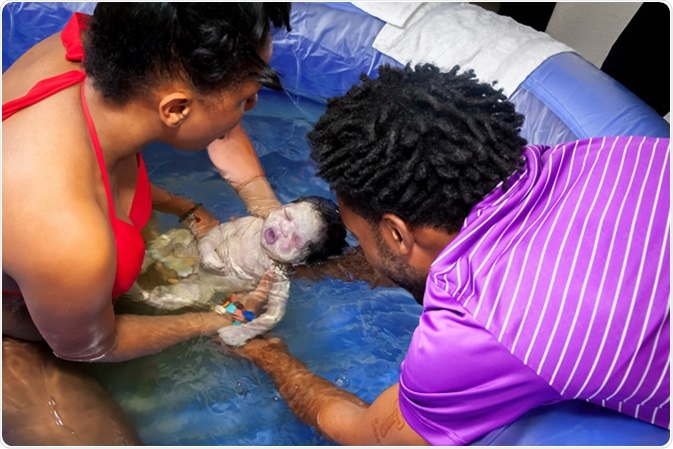Natural childbirth is a term coined by the English healthcare practitioner Grantly Dick-Read, who published a short book treating of labor pain in women in 1933. It is not merely a technique of pain relief during labor, but should be seen as a philosophy of life itself, which emphasizes the physiological nature of childbirth rather than the event as an illness.
It focuses on the integrating the mental, social and spiritual aspects of childbearing, viewing it as one of the most sacred and responsible primary functions and privileges of female life. Natural childbirth may thus be seen also as a challenge to the mechanistic and masculine concepts of ‘treating’ pregnancy and delivery that evolved over the last two centuries.
Instead of having the doctor or other health professional deliver the baby, the system of natural childbirth advocated a wide variety of techniques to help provide adequate support for women to deliver their babies with minimal medical intervention unless required.

Couple delivers their newborn baby in a pool of water at home during a homebirth with help from their midwife. Image Credit: In The Light Photography / Shutterstock
Primitive vs Civilized Childbirth
One stream of natural childbirth remarked from anthropological studies that many primitive peoples experienced pregnancy and childbirth as wholly natural processes and had much less difficulty and pain during the whole duration. These societies placed a high value on the presence of children and the work of labor was duly recognized as nothing more and nothing less than the woman’s chief contribution to the survival of the people.
In contrast was the civilized viewpoint which produced a distorted idea of the process, focusing on its dangers and pains, which inevitably led to the build-up of tension within the female body that hindered the easy and natural dilatation of the cervix in response to uterine expulsive contractions.
This was considered to be the chief reason for pain during parturition in women, and the reason why natural childbirth proponents found it needful to train the modern woman to experience labor as a hard but immensely valuable experience which could be successfully and even victoriously faced as her own personal and fulfilling contribution to the social good.
The focus was chiefly upon the physiology of childbirth, explaining what each phase of new experience meant, and upon the many ways there were to find comfort and ease herself during each stage of labor. Cooperation and teamwork between the laboring mother and the support team was essential to produce shorter, effective labors and minimize medical interventions. Proper diet and posture was also held to be highly essential in promoting natural labor by emphasizing the feminine aspects of human nature.
Pain as Essential Feedback Regulator
A typical view of the events occurring during parturition from the natural childbirth perspective would be to consider each labor pain caused by each contraction as a stimulus for the woman to seek to ease herself, thus acting as a natural message from the woman’s body to move, change position, or nourish herself. This progressive cooperation by the woman with her body hastens and optimizes the baby’s passage through the birth canal to ensure a successful labor.
The entire absence of pain during labor would therefore be counterproductive, removing the crucial element of feedback and making the entire process sluggish. Moreover, the release of endorphins in increasing amounts during labor causes a corresponding change in the woman’s perception of pain, as well as a mood shift to a more intuitive, less rational frame of mind. This frees her from outward stimulation and helps her unconsciously to focus on the great work she is engaged in, doing whatever it takes to comfort herself and to carry it forward.
Rather than time, the outcome is the important objective, and neither the woman nor the support people around her are in a hurry to bring the process to an end. Instead, they trust the design of the parturition system and provide encouragement, nourishment, and comfort to bring it to a natural and expected end. The responses of the woman to what she is feeling help move the baby down the birth canal in synchrony with the cervical and uterine changes, and also help keep the perineum intact. The baby is also stimulated but not stressed, and is born alert and ready to survive.
Pain Relief During Labor
As already stated, natural childbirth is more than knowing several techniques to relieve labor pain. Yet these are important as natural choices which facilitate the outcome of labor, and may comprise:
- Moving about
- Music
- Massage
- Water baths
- Birthing ball use
- Relaxation and breathing techniques
- Change of position from sitting to leaning forward, on all fours, or squatting as felt necessary
- Acupuncture
- Aromatherapy
- Transcutaneous electrical nerve stimulation (TENS)
- Hot fomentation or ice pack application to the abdomen or the back
The support personnel are important not to tell the woman what to do or make the decisions for her, but to help her complete the hard work. They may include birth attendants or midwives, family, and friends. They also help her get enough food and fluids to maintain her energy level, reassure her of her capability to succeed in giving birth to a child, and encourage her to do what feels right and relieves the pain.
Natural childbirth does not mean that every labor will end without any intervention. However, it places priority on the natural steps of childbirth and promotes reliance on the physiology of the process designed to help the woman choose what would aid her labor, rather than on external manipulations and interventions.
References
Further Reading
Last Updated: Feb 26, 2019